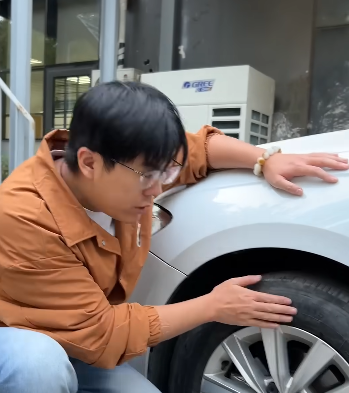
Car tires might seem like simple rubber rings attached to your vehicle, but they hold more secrets than most people realize. From the materials used in their construction to the patterns etched into their surface, every detail has a purpose. Understanding these secrets can improve your driving safety, extend the life of your tires, and even save you money on fuel. So, let’s dive deep into the fascinating world of car tires.
1. Not Just Rubber — The Real Materials Behind Tires
Most people think tires are made entirely of rubber, but the truth is more complex. A modern tire is a highly engineered product made from a blend of natural rubber, synthetic rubber, steel, textiles (like polyester and nylon), carbon black, silica, and various chemical additives.
The inner layers of a tire include steel belts for strength and stability, while textile cords provide flexibility. The outer tread is made of a special rubber compound that balances durability with grip. Manufacturers fine-tune this rubber blend to perform well in different weather conditions — like soft rubber for winter tires and harder compounds for summer ones.
2. Tire Tread Patterns Aren’t Random
If you’ve ever looked closely at the tread of a tire, you’ll notice grooves, channels, and blocks. These aren’t just for aesthetics. Each pattern is carefully designed to serve specific purposes:
- Symmetrical tread patterns are common on standard cars and provide good all-around performance.
- Asymmetrical tread patterns offer enhanced grip on both dry and wet surfaces — great for high-performance vehicles.
- Directional tread patterns are designed to rotate in one direction only, improving water evacuation and reducing hydroplaning.
For example, tires with deep grooves are ideal for wet climates, while off-road tires have aggressive, blocky patterns that dig into mud and gravel for traction.

3. The Mystery of Sidewall Codes
Ever noticed the strange sequence of numbers and letters on your tire’s sidewall, like 205/55R16 91V? This code tells you almost everything about your tire. Let’s decode it:
- 205 – Width of the tire in millimeters.
- 55 – Aspect ratio (height of the sidewall as a percentage of the width).
- R – Radial construction (which nearly all modern tires are).
- 16 – Diameter of the wheel in inches.
- 91 – Load index (how much weight the tire can carry).
- V – Speed rating (how fast the tire can safely go).
Knowing how to read this code helps you choose the right tire for your vehicle and ensures you stay within safety guidelines.
4. Tire Pressure Affects More Than You Think
Correct tire pressure isn’t just about avoiding a flat. It can significantly affect your:
- Fuel efficiency – Under-inflated tires increase rolling resistance, which means your engine works harder and uses more fuel.
- Tire lifespan – Incorrect pressure can cause uneven wear, shortening the tire’s life.
- Safety – Low pressure increases the risk of a blowout, especially at high speeds.
Always check your tire pressure at least once a month using a reliable gauge. Your car’s manual or a sticker on the driver’s door frame will tell you the correct PSI (pounds per square inch) for your tires.
5. Tires Talk — If You Know How to Listen
Your tires can tell you a lot about your car’s health. Uneven tread wear patterns can signal other problems:
- Center wear means the tire is over-inflated.
- Edge wear points to under-inflation.
- Cupping (wavy dips) may indicate suspension issues.
- Feathering (sharp edges on tread blocks) could mean poor alignment.
Regularly inspecting your tires can help you catch and fix problems early — before they lead to bigger repair bills.

6. The Age of Your Tires Matters — Even If They Look New
Tires degrade over time, even if you don’t drive much. Sunlight, oxygen, and temperature changes break down the rubber. That’s why most manufacturers recommend replacing tires every 6 to 10 years, regardless of tread depth.
To check a tire’s age, look for the DOT code on the sidewall. The last four digits indicate the week and year it was made. For example, 2519 means the tire was manufactured in the 25th week of 2019.
7. Seasonal Tires Aren’t Just a Marketing Gimmick
Many drivers try to use the same set of tires all year long. While this might be fine in mild climates, it’s not safe in areas with extreme temperatures.
- Summer tires offer better performance and grip in warm conditions but harden and lose effectiveness in the cold.
- Winter tires remain soft in freezing temperatures and have special tread for snow and ice.
- All-season tires try to strike a balance but don’t match the performance of seasonal tires in extreme weather.
Swapping tires based on the season gives you better traction, shorter braking distances, and increased safety.

8. Run-Flat Tires and Tire Pressure Monitoring Systems (TPMS)
Modern technology has added new safety features to tires. Run-flat tires can keep working for up to 50 miles even after a puncture. This gives you time to find a repair shop without being stranded.
Meanwhile, TPMS alerts you when a tire is losing pressure. Some cars have sensors inside the tire, while others use indirect methods based on wheel rotation. If your TPMS light comes on, don’t ignore it — check your tire pressure right away.
9. Rotation, Alignment, and Balancing — Why They Matter
These three maintenance tasks are key to maximizing tire life and safety:
- Rotation ensures even wear. Front and rear tires wear differently, so rotating them every 5,000–8,000 miles balances the wear.
- Alignment keeps your wheels pointed in the right direction. Poor alignment causes tires to wear quickly and unevenly.
- Balancing ensures that weight is evenly distributed around each tire and wheel. Unbalanced tires can cause vibrations and damage suspension components.
Regular tire maintenance improves handling, comfort, and longevity.
10. Green Tires — The Future of Eco-Friendly Driving
With growing concern for the environment, manufacturers are developing eco-friendly tires. These tires use sustainable materials like dandelion rubber and reduce rolling resistance to improve fuel economy.
Some tires even have smart sensors embedded in them to report real-time data on pressure, temperature, and tread wear. This technology helps drivers maintain optimal performance and safety — and might become standard in the near future.
Conclusion
Car tires are much more than black circles of rubber. They are high-tech, safety-critical components that play a vital role in your driving experience. By learning the secrets behind their design, materials, and maintenance, you empower yourself to drive smarter, safer, and more economically. So next time you check your tires, remember — there’s a whole lot going on beneath the surface.
Do you know the secrets of your tires? Now you do.


